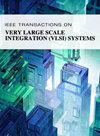Backside Active Power Delivery With Hybrid DC–DC Converter Enabled by Amorphous Oxide Semiconductor Transistors
IF 3.1
2区 工程技术
Q2 COMPUTER SCIENCE, HARDWARE & ARCHITECTURE
IEEE Transactions on Very Large Scale Integration (VLSI) Systems
Pub Date : 2025-03-28
DOI:10.1109/TVLSI.2025.3570078
引用次数: 0
Abstract
The increasing demand for energy-efficient computing has created the need for advanced power management solutions. Backside power delivery network (BSPDN) has been introduced in the industry for 2-nm node with passive wires. In this work, we propose adding active components (power transistors) to the backside of silicon in a back-end-of-line (BEOL)-compatible fabrication process. The goal is to enable 12–0.7-V voltage downconversion at the backside of silicon (near the point of load, i.e., the frontside logic compute die) to minimize the IR drop and improve overall system-level conversion efficiency. This work leverages a hybrid monolithic 3-D (M3D)dc-dc converter architecture combining switched-capacitor (SC) and synchronous buck converter topologies with BEOL-compatible active and passive devices. The design employs amorphous tungsten-doped indium oxide (IWO) transistors, which offer high breakdown voltage and tunable threshold voltages, supporting both enhancement and depletion modes for efficient switching. With the experimentally calibrated compact models, the simulated hybrid converter design achieves 12–0.7-V conversion with a peak efficiency of 95.6% at a power density of 330 mW/mm2, demonstrating the feasibility of M3D SC dc-dc converters for next-generation power management in high-performance edge devices.基于非晶氧化物半导体晶体管的混合DC-DC变换器的背面有源功率输出
对节能计算日益增长的需求催生了对先进电源管理解决方案的需求。业界已经引入了采用无源导线的2nm节点后向输电网络(BSPDN)。在这项工作中,我们提出在后端线(BEOL)兼容的制造工艺中,在硅的背面添加有源元件(功率晶体管)。目标是在硅片背面(靠近负载点,即前端逻辑计算芯片)实现12 - 0.7 v电压下变频,以最小化IR下降并提高整体系统级转换效率。这项工作利用了混合单片3-D (M3D)dc-dc转换器架构,将开关电容器(SC)和同步降压转换器拓扑与beol兼容的有源和无源器件结合在一起。该设计采用非晶钨掺杂氧化铟(IWO)晶体管,提供高击穿电压和可调阈值电压,支持高效开关的增强和耗尽模式。通过实验校准的紧凑模型,模拟的混合转换器设计在功率密度为330 mW/mm2的情况下实现了12 - 0.7 v的转换,峰值效率为95.6%,证明了M3D SC dc-dc转换器用于高性能边缘设备的下一代电源管理的可行性。
本文章由计算机程序翻译,如有差异,请以英文原文为准。
求助全文
约1分钟内获得全文
求助全文
来源期刊
CiteScore
6.40
自引率
7.10%
发文量
187
审稿时长
3.6 months
期刊介绍:
The IEEE Transactions on VLSI Systems is published as a monthly journal under the co-sponsorship of the IEEE Circuits and Systems Society, the IEEE Computer Society, and the IEEE Solid-State Circuits Society.
Design and realization of microelectronic systems using VLSI/ULSI technologies require close collaboration among scientists and engineers in the fields of systems architecture, logic and circuit design, chips and wafer fabrication, packaging, testing and systems applications. Generation of specifications, design and verification must be performed at all abstraction levels, including the system, register-transfer, logic, circuit, transistor and process levels.
To address this critical area through a common forum, the IEEE Transactions on VLSI Systems have been founded. The editorial board, consisting of international experts, invites original papers which emphasize and merit the novel systems integration aspects of microelectronic systems including interactions among systems design and partitioning, logic and memory design, digital and analog circuit design, layout synthesis, CAD tools, chips and wafer fabrication, testing and packaging, and systems level qualification. Thus, the coverage of these Transactions will focus on VLSI/ULSI microelectronic systems integration.

 求助内容:
求助内容: 应助结果提醒方式:
应助结果提醒方式:


